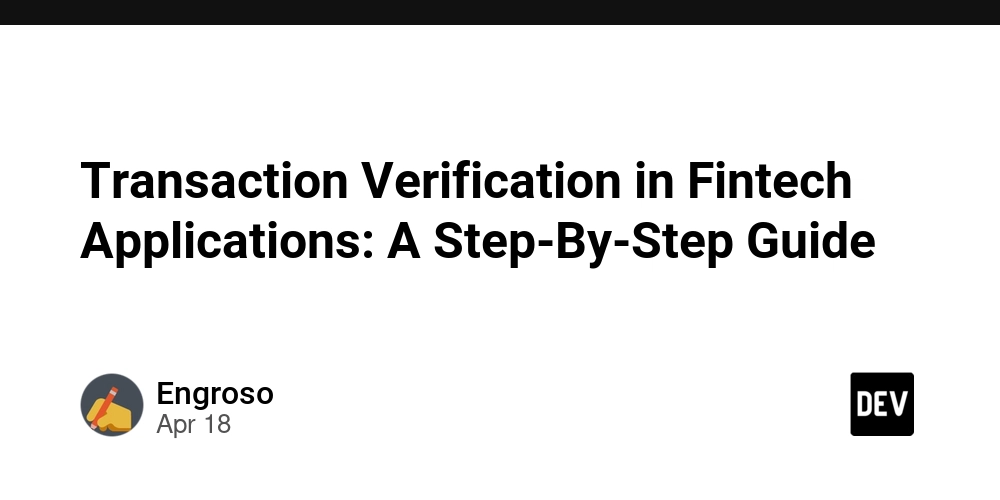Transaction Verification in Fintech Applications: A Step-By-Step Guide
Setting up a basic transaction system for payments and transfers is usually the first step in building a fintech app in Nigeria. However, as your platform scales, risks such as increased fraud, discrepancies in transaction data, customer disputes, and unnoticed failed transactions become significant concerns. These issues generally pose a great threat, so you need a reliable transaction verification system to address them. This will ensure every transaction is legitimate, minimise fraud, and keep your platform compliant, all while protecting customer confidence. Risks of Not Implementing Transaction Verification Contradictions in Transaction Data: When your application runs a bulk load of transactions, errors like sending an incorrect amount or currency or even making a duplicate charge can occur. When these issues happen, and the transactions aren’t being verified, they result in financial inconsistencies that become difficult to trace. Customer Disputes: Unverified transactions often lead to customer issues, including disputes over incorrect charges or failed payments. These disputes can harm your reputation and frustrate users. Loss of Customer Trust: While your customers expect secure and reliable transactions, failing to implement verification can erode their confidence and trust, ultimately affecting your platform’s reputation. Revenue Loss: When errors like incorrect charges, fraudulent transfers, or chargebacks happen, they lead to significant financial losses and directly affect your business’s bottom line. Increased Fraud Risk: Without implementing a transaction verification process, fraudulent transactions can slip through unnoticed, leading to unauthorised charges and exposing your platform to security breaches. Steps to Solving These Challenges Now that you know why it is essential to verify transactions, the question arises, “Are your transaction services secure and accurate?” By integrating advanced technology with compliance measures, you can overcome the risks and consequences of running your fintech app without transaction verification. Flutterwave offers a unified system to manage diverse regulations, including Know Your Customer (KYC) and Anti-Money Laundering requirements, across multiple countries. By utilising automated compliance checks and real-time transaction monitoring, Flutterwave ensures that you remain compliant with local financial laws while minimising the risk of costly errors and fraud. Check out this guide on how to implement Flutterwave and get in-depth details of the above topic.

Setting up a basic transaction system for payments and transfers is usually the first step in building a fintech app in Nigeria. However, as your platform scales, risks such as increased fraud, discrepancies in transaction data, customer disputes, and unnoticed failed transactions become significant concerns.
These issues generally pose a great threat, so you need a reliable transaction verification system to address them. This will ensure every transaction is legitimate, minimise fraud, and keep your platform compliant, all while protecting customer confidence.
Risks of Not Implementing Transaction Verification
Contradictions in Transaction Data: When your application runs a bulk load of transactions, errors like sending an incorrect amount or currency or even making a duplicate charge can occur. When these issues happen, and the transactions aren’t being verified, they result in financial inconsistencies that become difficult to trace.
Customer Disputes: Unverified transactions often lead to customer issues, including disputes over incorrect charges or failed payments. These disputes can harm your reputation and frustrate users.
Loss of Customer Trust: While your customers expect secure and reliable transactions, failing to implement verification can erode their confidence and trust, ultimately affecting your platform’s reputation.
Revenue Loss: When errors like incorrect charges, fraudulent transfers, or chargebacks happen, they lead to significant financial losses and directly affect your business’s bottom line.
Increased Fraud Risk: Without implementing a transaction verification process, fraudulent transactions can slip through unnoticed, leading to unauthorised charges and exposing your platform to security breaches.
Steps to Solving These Challenges
Now that you know why it is essential to verify transactions, the question arises, “Are your transaction services secure and accurate?”
By integrating advanced technology with compliance measures, you can overcome the risks and consequences of running your fintech app without transaction verification. Flutterwave offers a unified system to manage diverse regulations, including Know Your Customer (KYC) and Anti-Money Laundering requirements, across multiple countries. By utilising automated compliance checks and real-time transaction monitoring, Flutterwave ensures that you remain compliant with local financial laws while minimising the risk of costly errors and fraud.
Check out this guide on how to implement Flutterwave and get in-depth details of the above topic.









































































































































































![[The AI Show Episode 144]: ChatGPT’s New Memory, Shopify CEO’s Leaked “AI First” Memo, Google Cloud Next Releases, o3 and o4-mini Coming Soon & Llama 4’s Rocky Launch](https://www.marketingaiinstitute.com/hubfs/ep%20144%20cover.png)



























































































































![[DEALS] The All-in-One Microsoft Office Pro 2019 for Windows: Lifetime License + Windows 11 Pro Bundle (89% off) & Other Deals Up To 98% Off](https://www.javacodegeeks.com/wp-content/uploads/2012/12/jcg-logo.jpg)




























![Is this too much for a modular monolith system? [closed]](https://i.sstatic.net/pYL1nsfg.png)






















































































































_Andreas_Prott_Alamy.jpg?width=1280&auto=webp&quality=80&disable=upscale#)





























































































![What features do you get with Gemini Advanced? [April 2025]](https://i0.wp.com/9to5google.com/wp-content/uploads/sites/4/2024/02/gemini-advanced-cover.jpg?resize=1200%2C628&quality=82&strip=all&ssl=1)













![Apple Shares Official Trailer for 'Long Way Home' Starring Ewan McGregor and Charley Boorman [Video]](https://www.iclarified.com/images/news/97069/97069/97069-640.jpg)
![Apple Watch Series 10 Back On Sale for $299! [Lowest Price Ever]](https://www.iclarified.com/images/news/96657/96657/96657-640.jpg)
![EU Postpones Apple App Store Fines Amid Tariff Negotiations [Report]](https://www.iclarified.com/images/news/97068/97068/97068-640.jpg)
![Apple Slips to Fifth in China's Smartphone Market with 9% Decline [Report]](https://www.iclarified.com/images/news/97065/97065/97065-640.jpg)



































































































































